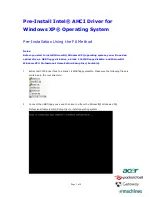
ExtremeWare XOS Overview
ExtremeWare XOS 11.1 Concepts Guide
26
sFlow
sFlow
®
is a technology for monitoring traffic in data networks containing switches and routers. The
technology relies on statistical sampling of packets from high-speed networks, plus periodic gathering
of the statistics. A UDP datagram format is defined to send the information to an external entity for
analysis. sFlow consists of a Management Information Base (MIB) and a specification of the packet
format for forwarding information to a remote agent. Details of sFlow specifications can be found in
RFC 3176, and specifications and more information can be found at the following website:
http://www.sflow.org
The ExtremeWare XOS implementation is based on sFlow version 5, an improvement from that
specified in RFC3176.
For information on sFlow, see
Chapter 7
.
ESRP
With software version 11.0, you can use the Extreme Standby Routing Protocol (ESRP). ESRP is an
Extreme Networks proprietary protocol that allows multiple switches to provide redundant routing
services to users. ESRP also provides Layer 2 redundancy; the Layer 3 and Layer 2 redundancy can be
used separately or together.
Using ESRP allows you to simplify your network, and it works very well in meshed networks where
Layer 2 loop protection and Layer 3 redundancy are both required.
For more information on ESRP, see
Chapter 17
.
IP Multinetting
Software version 11.0 of ExtremeWare XOS introduces IP multinetting, which allows you to overlap
multiple subnets onto the same physical segment. IP multinetting is designed for use in legacy
networks, as a transitional tactic.
For more information on IP multinetting, see
Chapter 19
.
RMON
With software version 11.1, ExtremeWare XOS introduces Remote Monitoring (RMON), which supports
RFC 1757 and RFC 2021. RMON provides a method of monitoring the network by collecting Ethernet
port statistics and to set systemwide alarm variables.
For more information on RMON, see
Chapter 7
.
ELRP
ExtremeWare XOS 11.1 introduces support for the Extreme Loop Recovery Protocol (ELRP) ELRP allows
you to prevent, detect, and recover from Layer 2 loops in the network. Once a loop is detected through
ELRP, different recovery actions can be taken such as blocking certain ports to prevent looping or
logging a message to the system log. The action taken is largely dependent on the protocol using ELRP
to detect loops in the network.
Содержание ExtremeWare XOS 11.1
Страница 16: ...Contents ExtremeWare XOS 11 1 Concepts Guide 16...
Страница 20: ...Preface ExtremeWare XOS 11 1 Concepts Guide 20...
Страница 21: ...1 Using ExtremeWare XOS...
Страница 22: ......
Страница 78: ...Managing the ExtremeWare XOS Software ExtremeWare XOS 11 1 Concepts Guide 78...
Страница 168: ...Virtual LANs ExtremeWare XOS 11 1 Concepts Guide 168...
Страница 200: ...Policies and ACLs ExtremeWare XOS 11 1 Concepts Guide 200...
Страница 252: ...Security ExtremeWare XOS 11 1 Concepts Guide 252...
Страница 265: ...2 Using Switching and Routing Protocols...
Страница 266: ......
Страница 294: ...Ethernet Automatic Protection Switching ExtremeWare XOS 11 1 Concepts Guide 294...
Страница 354: ...Extreme Standby Router Protocol ExtremeWare XOS 11 1 Concepts Guide 354...
Страница 416: ...IP Multicast Routing ExtremeWare XOS 11 1 Concepts Guide 416...
Страница 417: ...3 Appendixes...
Страница 418: ......
Страница 432: ...Software Upgrade and Boot Options ExtremeWare XOS 11 1 Concepts Guide 432...
















































